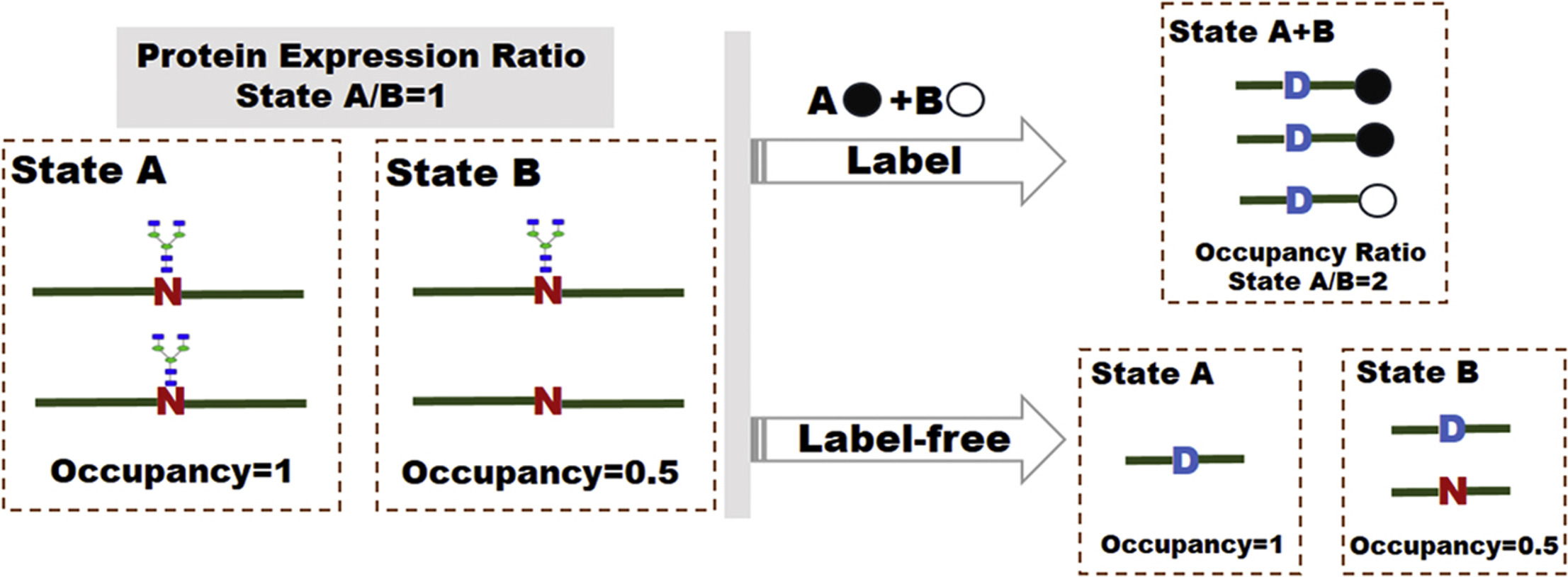N- and O-Glycosylation Site Occupation Analysis Services
N- and O-glycosylation site occupation analysis is a powerful technique designed to assess whether specific sites on a protein are glycosylated and to what extent. As one of the most prevalent post-translational modifications in mammalian proteins, glycosylation influences critical biological processes such as protein folding, stability, cellular trafficking, and signal transduction. Changes in glycosylation site occupancy can significantly alter protein function and activity, making this analysis particularly valuable for therapeutic protein quality control, disease research, target validation, and glycoprotein function studies.
MtoZ Biolabs offers N- and O-glycosylation Site Occupation Analysis Services by integrating high-resolution mass spectrometry with optimized glycopeptide enrichment, tailored enzymatic digestion protocols, and quantitative workflows. Through precise comparison of glycosylated and non-glycosylated peptide species, we deliver accurate site-specific occupancy measurements, empowering researchers to monitor dynamic glycosylation changes across biological conditions and gain deeper insights into glycoprotein structure and function.
Services at MtoZ Biolabs
MtoZ Biolabs delivers an end-to-end solution encompassing identification, quantification, and structural characterization of glycosylation sites. Our approach enables a comprehensive understanding of glycan-mediated regulatory mechanisms through the following service modules:
1. Precise Identification of Glycosylation Sites
Utilizing specific enzymatic digestion, glycopeptide enrichment, and high-resolution MS platforms, we confidently localize N- and O-glycosylation sites, including those with low abundance or novel glycan modifications.
2. Quantification of Site-Specific Occupancy
Site occupancy is calculated by comparing the intensities of glycosylated and non-glycosylated peptide counterparts, revealing the extent of modification and enabling evaluation of regulatory potential and dynamic changes.
3. Glycan Structure and Microheterogeneity Profiling
High-resolution LC-MS/MS coupled with targeted exoglycosidase treatment allows for the structural elucidation of glycans at specific sites. This provides insights into glycoform distributions and site-specific heterogeneity.
4. Functional Annotation and Structural Mapping
Through database alignment and structural modeling, we annotate the spatial localization and conservation of glycosylation sites, supporting prediction of their impact on protein folding, stability, and interactions.

Zhang, S. et al. Talanta. 2017.
Figure 1. MS-Based Quantification of N-Glycosylation Site Occupancy
Analysis Workflow
1. Protein Digestion
Proteins are enzymatically digested using site-specific proteases such as trypsin to generate peptides containing potential glycosylation sites.
2. Glycopeptide Enrichment and Control Setup
Glycopeptides are enriched from the digested samples, while an untreated aliquot is retained to serve as a non-glycosylated peptide control.
3. High-Resolution LC-MS/MS Acquisition
Peptides and glycopeptides are analyzed in parallel using Orbitrap or Q Exactive platforms to ensure accurate and high-coverage identification.
4. Occupancy Rate Calculation
Site-specific glycosylation occupancy is quantified by comparing chromatographic peak areas of glycosylated versus non-glycosylated peptides, using diagnostic glycan ions and database-confirmed peptide features.
5. Bioinformatics Analysis and Visualization
We provide visualized reports including glycosylation site distribution maps, heatmaps, bar plots, and differential occupancy profiles.
Why Choose MtoZ Biolabs?
✅ State-of-the-Art Mass Spectrometry Platforms: We employ high-resolution Orbitrap-based MS systems with advanced fragmentation modes to achieve high sensitivity, accuracy, and coverage for both N- and O-linked glycosylation site analysis.
✅ Optimized Glycopeptide Enrichment Techniques: Multiple enrichment strategies such as HILIC, ZIC-HILIC, and lectin affinity are applied to improve detection sensitivity and specificity, particularly for low-abundance glycopeptides in complex samples.
✅ Comprehensive Structural Profiling: By integrating different enzymatic digestion methods and MS/MS fragmentation modes, we can determine glycan structures, glycosylation site localization, linkage type, and glycoform heterogeneity in a single workflow.
✅ Flexible Quantitative Strategies: Both label-free and label-based quantification options such as TMT and iTRAQ are available, accommodating different research scales and objectives related to glycosylation occupancy studies.
✅ Integrated Multi-Omics Analysis: We support the integration of glycoproteomic data with transcriptomic and functional proteomic datasets to construct regulatory networks and explore glycosylation-mediated signaling pathways.
Sample Submission Suggestions
MtoZ Biolabs offers N- and O-Glycosylation Site Occupation Analysis Services with flexible compatibility for various sample types such as purified proteins, therapeutic antibodies, cell lysates, serum, plasma, and tissue extracts. For optimal results, we recommend discussing your research goals and sample characteristics with our technical team in advance. We will provide clear instructions on sample preparation and shipping to ensure a seamless submission process.
Applications
N- and O-Glycosylation Site Occupation Analysis Services are applicable in a wide range of biological and biopharmaceutical contexts:
· Quality Control of Recombinant Proteins: Evaluate glycosylation consistency and occupancy uniformity in recombinant products and expression systems.
· Glycosylation Characterization of Antibody Therapeutics: Analyze Fc region glycosylation and its impact on antibody-dependent cellular cytotoxicity, effector function, and pharmacokinetics.
· Disease-Associated Glycosylation Research: Identify key glycosylation sites and glycoforms linked to disease phenotypes such as cancer, autoimmunity, and metabolic disorders.
· Signal Transduction Mechanism Exploration: Investigate how glycosylation modulates the activity, subcellular localization, and protein-protein interactions of signaling molecules.
· Glycoprotein-Based Vaccine Development: Identify high-occupancy glycosylation sites as potential immunogenic epitopes or antibody-accessible targets for vaccine design.
If you are conducting research on glycosylation regulatory mechanisms, characterizing glycan structures in biologics, or exploring glycoprotein-based therapeutic targets, MtoZ Biolabs offers advanced, reliable N- and O-Glycosylation Site Occupation Analysis Services. Our expert team and cutting-edge technology platform are ready to support your scientific objectives. Contact us today to receive a tailored proposal and consultation.
What Could be Included in the Report?
1. Detailed report of identified glycosylation sites including peptide sequence, site position, and confidence scores
2. Quantitative results of site-specific glycosylation occupancy
3. Annotated glycan structure and heterogeneity profiles
4. Visualized data outputs including bar plots, heatmaps, and site maps
5. Multi-omics integration report if applicable
6. Final technical report with expert data interpretation and recommendations
Related Services
N- and O-Glycosylation Site Analysis Services
N- and O-Linked Glycosylation Mapping Service
How to order?







